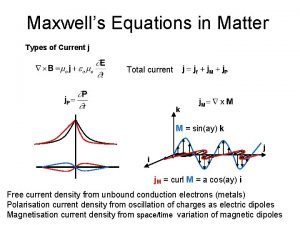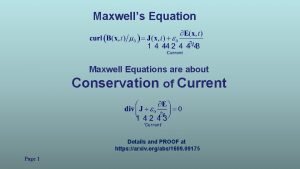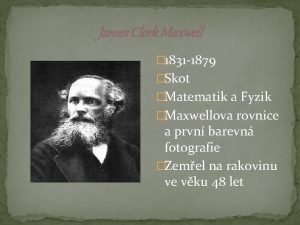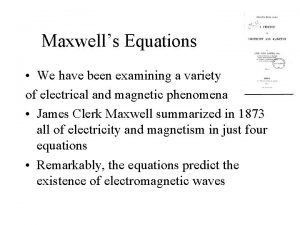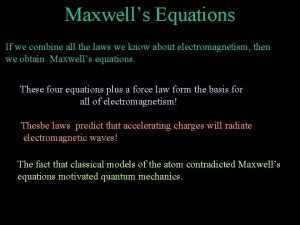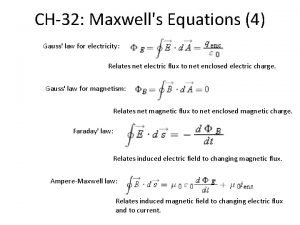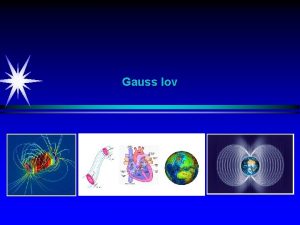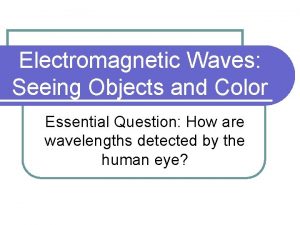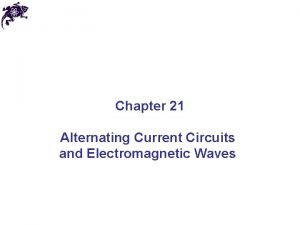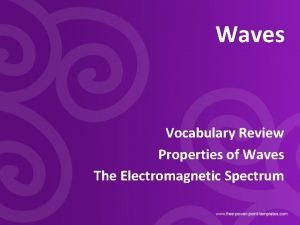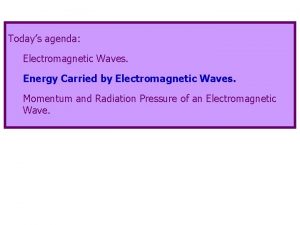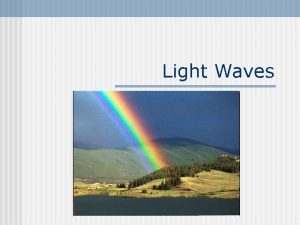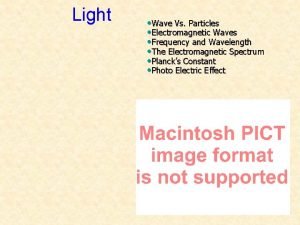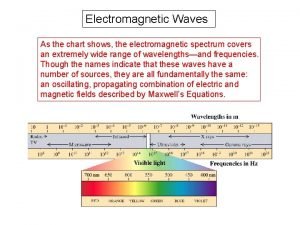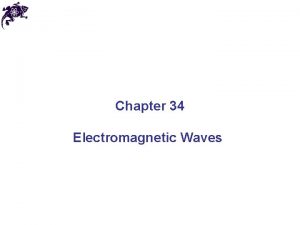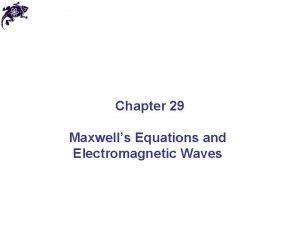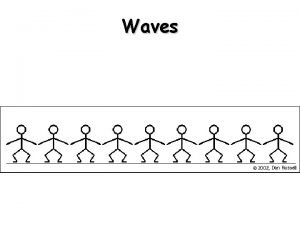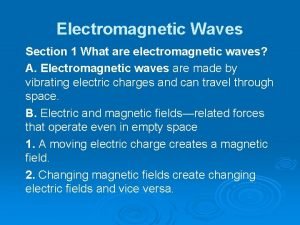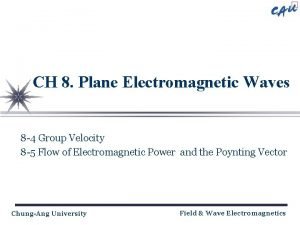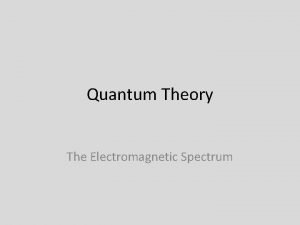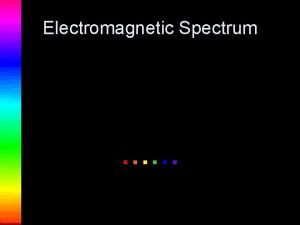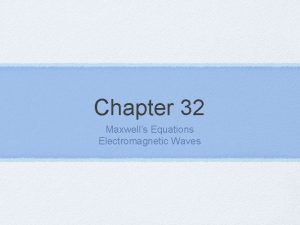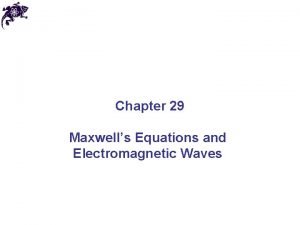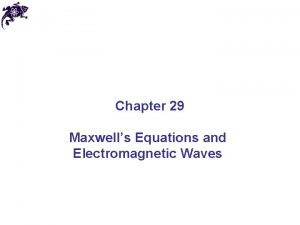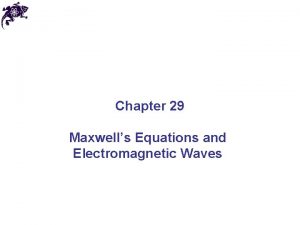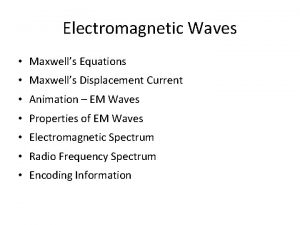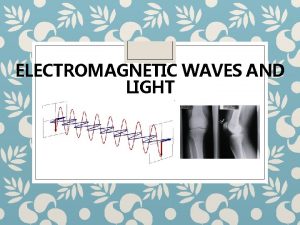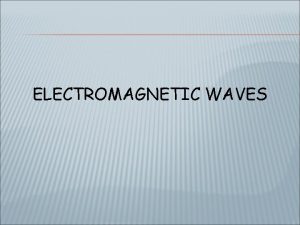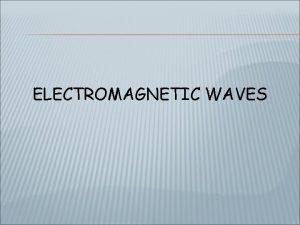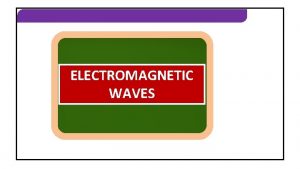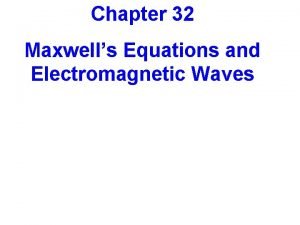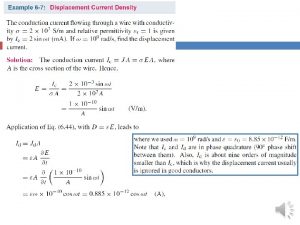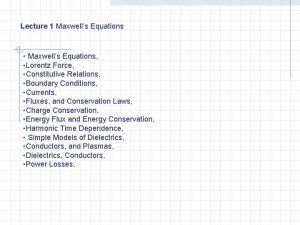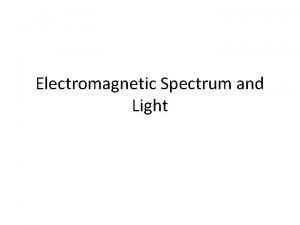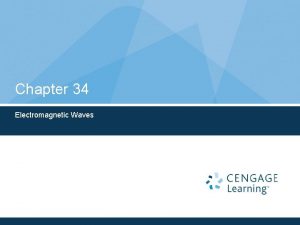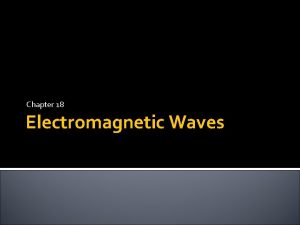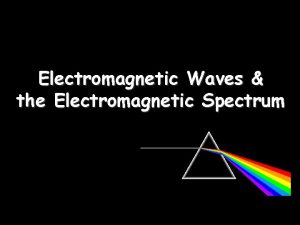Chapter 32 Maxwells Equations and Electromagnetic Waves Main































- Slides: 31

Chapter 32 Maxwell’s Equations and Electromagnetic Waves

Main Points of Chapter 32 • Maxwell’s Equations: • Gauss’s Law of Electricity • Gauss’s Law of Magnetism • Faraday’s Law of Induction • Maxwell’s Displacement Current and Ampère’s Law • Electromagnetic Waves and the Speed of Light

Gauss’ Law of Electricity enclosed The electric flux through a closed surface that encloses no net charge is zero.

Gauss’ Law for Magnetism • No magnetic monopoles (single magnetic charge) have ever been observed • Magnetic field lines must be continuous • The magnetic “charge” inside any closed surface must always be zero.

Gauss’ Law for Magnetism • Definition of magnetic flux: • Therefore, for any closed surface: This is Gauss’ law for magnetism.

Gauss’ Law for Magnetism Field lines for a bar magnet: • Similar to those for a magnetic dipole • But no magnetic charges, so all field lines are closed loops

Faraday’s Law of Induction A changing magnetic flux induces an electric field; this is a generalization of Faraday’s law. The electric field will exist regardless of whethere any conductors around. Although static electric fields are conservative fields, when the electric field produced by a changing magnetic field is a nonconservative field.

Ampère’s Law • Experimental observation: two parallel current-carrying wires exert forces on each other • Assumption: current creates a magnetic field • Field can be mapped out • Field makes circles around wire, direction given by right-hand rule

Ampère’s Law Field around a current-carrying wire:

Ampère’s Law In this case, there is a current through the surface whose edge is defined by the path. Ampère’s Law is the generalization of this, valid for any current and path:

The Maxwell Displacement Current • Ampère’s law has a flaw when currents are varying • One closed line can be the edge of an infinite number of surfaces • As long as currents through all surfaces are the same, no problem • But if current is varying this may not be true






Note: (1) A changing magnetic field creates an electric field (Faraday’s Law of Induction); (2) A changing electric field creates a magnetic field (Ampère’s Law: Displacement Current)

Maxwell’s Equations I. Gauss’ law for electric fields: equivalent to Coulomb’s law II. Gauss’ law for magnetic fields: no magnetic monopoles

Maxwell’s Equations III. Generalized Ampère’s law: changing electric flux creates magnetic field IV. Faraday’s law: changing magnetic flux creates electric field

Electromagnetic Waves • Electric and magnetic fields are coupled through Ampère’s and Faraday’s laws • Once created they can continue to propagate without further input • Only accelerating charges will create electromagnetic waves

Electromagnetic Waves Using Maxwell’s equations to find an equation for the electric field: This is a wave equation, with solution: And propagation speed:

Electromagnetic Waves This is the speed of light, c! The magnetic field obeys the same wave equation.

Electromagnetic Waves The amplitude of the magnetic field is related to the amplitude of the electric field: Also, the two fields are everywhere orthogonal:

Electromagnetic Waves • Electromagnetic waves are transverse – the E and B fields are perpendicular to the direction of propagation • The E and B fields are in phase



Electromagnetic Waves The electromagnetic spectrum:

Electromagnetic Waves • Electromagnetic waves travel more slowly through a medium by a factor n: • This defines n, the index of refraction.

Electromagnetic Waves • Except for ferromagnets, the speed can be written: So:

The Maxwell Displacement Current • This can be fixed by adding a term called the displacement current • Displacement current is zero unless there is a changing electric field Generalized form of Ampère’s law:

The Maxwell Displacement Current For example, a capacitor charging up: Surface 1 has a current going through it but Surface 2 does not But: electric flux is changing through Surface 2
 Mechanical waves and electromagnetic waves similarities
Mechanical waves and electromagnetic waves similarities Example of mechanical waves
Example of mechanical waves Mechanical waves and electromagnetic waves
Mechanical waves and electromagnetic waves Difference between matter waves and electromagnetic waves
Difference between matter waves and electromagnetic waves Mechanical waves and electromagnetic waves similarities
Mechanical waves and electromagnetic waves similarities Mechanical and electromagnetic waves
Mechanical and electromagnetic waves Light and sound travel in waves true or false
Light and sound travel in waves true or false Examples of mechanical and electromagnetic waves
Examples of mechanical and electromagnetic waves Maxwells equations in matter
Maxwells equations in matter Maxwell equation
Maxwell equation Maxwells equations
Maxwells equations Maxwell's equations faraday's law
Maxwell's equations faraday's law Maxwell equations
Maxwell equations Gauss law
Gauss law Blger
Blger Electromagnetic waves seeing objects and color
Electromagnetic waves seeing objects and color Alternating current circuits and electromagnetic waves
Alternating current circuits and electromagnetic waves Compare and contrast p waves and s waves using venn diagram
Compare and contrast p waves and s waves using venn diagram Electromagnetic waves vocabulary
Electromagnetic waves vocabulary Electromagnetic wave energy density
Electromagnetic wave energy density Electromagnetic waves characteristics
Electromagnetic waves characteristics Electromagnetic waves frequency
Electromagnetic waves frequency Electromagnetic waves chart
Electromagnetic waves chart Radiation powerpoint template free
Radiation powerpoint template free Maxwell theory of electromagnetic waves
Maxwell theory of electromagnetic waves Maxwell theory
Maxwell theory Electromagnetic energy
Electromagnetic energy Emona durmati lyrics
Emona durmati lyrics Section 1 what are electromagnetic waves
Section 1 what are electromagnetic waves Power of electromagnetic waves
Power of electromagnetic waves Wavelength of electromagnetic radiation formula
Wavelength of electromagnetic radiation formula Electron spectrum
Electron spectrum








